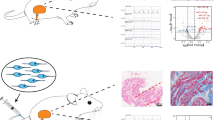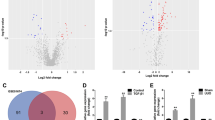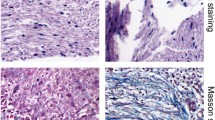Abstract
Bladder outlet obstruction (BOO) is a common disease that always make the bladder develops from inflammation to fibrosis. This study was to investigate the effect of exosomes from human urine-derived stem cells (hUSCs) on bladder fibrosis after BOO and the underlying mechanism. The BOO mouse model was established by inserting a transurethral catheter, ligation of periurethral wire, and removal of the catheter. Mouse primary bladder smooth muscle cells (BSMCs) were isolated and treated with TGFβ1 to mimic the bladder fibrosis model in vitro. Exosomes from hUSCs (hUSC-Exos) were injected into the bladder of BOO mice and added into the culture of TGFβ1-induced BSMCs. The associated factors in mouse bladder tissues and BSMCs were detected. It was confirmed that the treatment of hUSC-Exos alleviated mouse bladder fibrosis and down-regulated fibrotic markers (a-SMA and collagen III) in bladder tissues and TGFβ1-induced BSMCs. Overexpression of NRF1 in hUSC-Exos further improved the effects of hUSC-Exos on bladder fibrosis both in vivo and in vitro. TGFβR1 was a target of NRF1 and miR-301b-3p, and miR-301b-3p was a target of NRF1. It was next characterized that hUSC-Exos carried NRF1 to up-regulate miR-301B-3p, thereby reducing TGFβR1level. Our results illustrated that hUSC-Exos carried NRF1 to alleviate bladder fibrosis through regulating miR-301b-3p/TGFβR1 pathway.




Similar content being viewed by others
Data availability
The datasets generated during and/or analysed during the current study are available from the corresponding author on reasonable request.
References
Irwin DE, Kopp ZS, Agatep B, Milsom I, Abrams P (2011) Worldwide prevalence estimates of lower urinary tract symptoms, overactive bladder, urinary incontinence and bladder outlet obstruction. BJU Int 108(7):1132–1138
Gratzke C, Bachmann A, Descazeaud A, Drake MJ, Madersbacher S, Mamoulakis C, Oelke M, Tikkinen KAO, Gravas S (2015) EAU guidelines on the assessment of non-neurogenic male lower urinary tract symptoms including benign prostatic obstruction. Eur Urol 67(6):1099–1109
Fusco F, Creta M, De Nunzio C, Iacovelli V, Mangiapia F, Li Marzi V, Finazzi Agro E (2018) Progressive bladder remodeling due to bladder outlet obstruction: a systematic review of morphological and molecular evidences in humans. BMC Urol 18(1):15
Jock M, Leggett RE, Schuler C, Callaghan C, Levin RM (2014) Effect of partial bladder outlet obstruction and reversal on rabbit bladder physiology and biochemistry: duration of recovery period and severity of function. BJU Int 114(6):946–954
Chen L, Li L, Xing F, Peng J, Peng K, Wang Y, Xiang Z (2018) Human urine-derived stem cells: potential for cell-based therapy of cartilage defects. Stem Cells Int 2018:4686259
Zhao T, Luo D, Sun Y, Niu X, Wang Y, Wang C, Jia W (2018) Human urine-derived stem cells play a novel role in the treatment of STZ-induced diabetic mice. J Mol Histol 49(4):419–428
Bharadwaj S, Liu G, Shi Y, Markert C, Andersson KE, Atala A, Zhang Y (2011) Characterization of urine-derived stem cells obtained from upper urinary tract for use in cell-based urological tissue engineering. Tissue Eng Part A 17(15–16):2123–2132
Zhang D, Wei G, Li P, Zhou X, Zhang Y (2014) Urine-derived stem cells: a novel and versatile progenitor source for cell-based therapy and regenerative medicine. Genes Dis 1(1):8–17
Dong X, Zhang T, Liu Q, Zhu J, Zhao J, Li J, Sun B, Ding G, Hu X, Yang Z et al (2016) Beneficial effects of urine-derived stem cells on fibrosis and apoptosis of myocardial, glomerular and bladder cells. Mol Cell Endocrinol 427:21–32
Lai RC, Yeo RW, Lim SK (2015) Mesenchymal stem cell exosomes. Semin Cell Dev Biol 40:82–88
Mathivanan S, Ji H, Simpson RJ (2010) Exosomes: extracellular organelles important in intercellular communication. J Proteomics 73(10):1907–1920
Kang K, Ma R, Cai W, Huang W, Paul C, Liang J, Wang Y, Zhao T, Kim HW, Xu M et al (2015) Exosomes secreted from CXCR4 overexpressing mesenchymal stem cells promote cardioprotection via Akt signaling pathway following myocardial infarction. Stem Cells Int 2015:659890
Yuan J, Zhang S, Zhang Y (2018) Nrf1 is paved as a new strategic avenue to prevent and treat cancer, neurodegenerative and other diseases. Toxicol Appl Pharmacol 360:273–283
Falco MM, Bleda M, Carbonell-Caballero J, Dopazo J (2016) The pan-cancer pathological regulatory landscape. Sci Rep 6:39709
Ramos J, Yoo C, Felty Q, Gong Z, Liuzzi JP, Poppiti R, Thakur IS, Goel R, Vaid AK, Komotar RJ et al (2020) Sensitivity to differential NRF1 gene signatures contributes to breast cancer disparities. J Cancer Res Clin Oncol 146(11):2777–2815
Huang H, Ni H, Ma K, Zou J (2019) ANGPTL2 regulates autophagy through the MEK/ERK/Nrf-1 pathway and affects the progression of renal fibrosis in diabetic nephropathy. Am J Transl Res 11(9):5472–5486
Wang L, Yuan X, Lian L, Guo H, Zhang H, Zhang M (2021) Knockdown of lncRNA NORAD inhibits the proliferation, inflammation and fibrosis of human mesangial cells under high-glucose conditions by regulating the miR-485/NRF1 axis. Exp Ther Med 22(2):874
Koeck I, Burkhard FC, Monastyrskaya K (2016) Activation of common signaling pathways during remodeling of the heart and the bladder. Biochem Pharmacol 102:7–19
Song YS, Lee HJ, Doo SW, An J, Kim SU (2013) Enhanced angiogenesis and relaxation of bladder as early response to bladder outlet obstruction. Int J Urol 20(1):116–122
Lee SY, Chuang JH, Huang CC, Chou MH, Wu CL, Chen CM, Hsieh CS, Chen CL (2004) Identification of transforming growth factors actively transcribed during the progress of liver fibrosis in biliary atresia. J Pediatr Surg 39(5):702–708
Bartel DP (2009) MicroRNAs: target recognition and regulatory functions. Cell 136(2):215–233
Rupaimoole R, Slack FJ (2017) MicroRNA therapeutics: towards a new era for the management of cancer and other diseases. Nat Rev Drug Discov 16(3):203–222
Duan LJ, Qi J, Kong XJ, Huang T, Qian XQ, Xu D, Liang JH, Kang J (2015) MiR-133 modulates TGF-beta1-induced bladder smooth muscle cell hypertrophic and fibrotic response: implication for a role of microRNA in bladder wall remodeling caused by bladder outlet obstruction. Cell Signal 27(2):215–227
Zhao X, Wang K, Hu F, Qian C, Guan H, Feng K, Zhou Y, Chen Z (2015) MicroRNA-101 protects cardiac fibroblasts from hypoxia-induced apoptosis via inhibition of the TGF-beta signaling pathway. Int J Biochem Cell Biol 65:155–164
Guan J, Zhang J, Guo S, Zhu H, Zhu Z, Li H, Wang Y, Zhang C, Chang J (2015) Human urine-derived stem cells can be induced into osteogenic lineage by silicate bioceramics via activation of the Wnt/beta-catenin signaling pathway. Biomaterials 55:1–11
Zhu Q, Li Q, Niu X, Zhang G, Ling X, Zhang J, Wang Y, Deng Z (2018) Extracellular vesicles secreted by human urine-derived stem cells promote ischemia repair in a mouse model of hind-limb ischemia. Cell Physiol Biochem 47(3):1181–1192
Duan YR, Chen BP, Chen F, Yang SX, Zhu CY, Ma YL, Li Y, Shi J (2019) Exosomal microRNA-16–5p from human urine-derived stem cells ameliorates diabetic nephropathy through protection of podocyte. J Cell Mol Med. https://doi.org/10.1111/jcmm.14558
Steers WD, De Groat WC (1988) Effect of bladder outlet obstruction on micturition reflex pathways in the rat. J Urol 140(4):864–871
Wang N, Duan L, Ding J, Cao Q, Qian S, Shen H, Qi J (2019) MicroRNA-101 protects bladder of BOO from hypoxia-induced fibrosis by attenuating TGF-beta-smad2/3 signaling. IUBMB Life 71(2):235–243
Shen W, Li L, Song B, Li W, Zhou Z, Guo R (2013) Platelet-derived growth factor-BB increases expression of connexin 43 in an extracellular-regulated protein kinase-dependent manner in bladder smooth muscle cells. Int J Urol 20(1):123–130
Ma F, Higashira H, Ukai Y, Hanai T, Kiwamoto H, Park YC, Kurita T (2002) A new enzymic method for the isolation and culture of human bladder body smooth muscle cells. Neurourol Urodyn 21(1):71–79
Qiu-li Z, Wei W (2018) LncRNA-H19 induces retinal müller cell apoptosis via MiR-29b/FOXO4 axis in diabetic retinopathy. Clin Surg Res Commun. https://doi.org/10.31491/CSRC.2018.12.024
Niu Y, Zhou B, Wan C, wu R, Sun H, Lu D (2020) Down-regulation of miR-181a promotes microglial M1 polarization through increasing expression of NDRG2. Aging Pathobiol Ther 2(1):52–57
Ge B, Wu H, Shao D, Li S, Li F (2019) Interfering with miR-24 alleviates rotenone-induced dopaminergic neuron injury via enhancing autophagy by upregulating DJ-1. Aging Pathobiol Ther 1(1):17–24
Hsieh PF, Liu SF, Hung TJ, Hung CY, Liu GZ, Chuang LY, Chen MF, Wang JL, Shi MD, Hsu CH et al (2016) Elucidation of the therapeutic role of mitochondrial biogenesis transducers NRF-1 in the regulation of renal fibrosis. Exp Cell Res 349(1):23–31
Wei DW, Gui LS, Raza SHA, Zhang S, Khan R, Wang L, Guo HF, Zan LS (2017) NRF1 and ZSCAN10 bind to the promoter region of the SIX1 gene and their effects body measurements in Qinchuan cattle. Sci Rep 7(1):7867
Joseph JS, Ayeleso AO, Mukwevho E (2017) Exercise increases hyper-acetylation of histones on the Cis-element of NRF-1 binding to the Mef2a promoter: Implications on type 2 diabetes. Biochem Biophys Res Commun 486(1):83–87
Lv JW, Wen W, Jiang C, Fu QB, Gu YJ, Lv TT, Li ZD, Xue W (2017) Inhibition of microRNA-214 promotes epithelial-mesenchymal transition process and induces interstitial cystitis in postmenopausal women by upregulating Mfn2. Exp Mol Med 49(7):e357
Hughes FM Jr, Hill HM, Wood CM, Edmondson AT, Dumas A, Foo WC, Oelsen JM, Rac G, Purves JT (2016) The NLRP3 inflammasome mediates inflammation produced by bladder outlet obstruction. J Urol 195(5):1598–1605
Zeng J, Xie K, Jiang C, Mo J, Lindstrom S (2012) Bladder mechanoreceptor changes after artificial bladder outlet obstruction in the anesthetized rat. Neurourol Urodyn 31(1):178–184
Yuk SM, Shin JH, Song KH, Na YG, Lim JS, Sul CK (2015) Expression of brain derived-neurotrophic factor and granulocyte-colony stimulating factor in the urothelium: relation with voiding function. BMC Urol 15:37
Lee HJ, An J, Doo SW, Kim JH, Choi SS, Lee SR, Park SW, Song YS, Kim SU (2015) Improvement in spinal cord injury-induced bladder fibrosis using mesenchymal stem cell transplantation into the bladder wall. Cell Transplant 24(7):1253–1263
Cui M, Atmanli A, Morales MG, Tan W, Chen K, Xiao X, Xu L, Liu N, Bassel-Duby R, Olson EN (2021) Nrf1 promotes heart regeneration and repair by regulating proteostasis and redox balance. Nat Commun 12(1):5270
Yang M, Zhang J, Jin X, Li C, Zhou G, Feng J (2020) NRF1-enhanced miR-4458 alleviates cardiac hypertrophy through releasing TTP-inhibited TFAM. In Vitro Cell Dev Biol Anim 56(2):120–128
Chong H, Wei Z, Na M, Sun G, Zheng S, Zhu X, Xue Y, Zhou Q, Guo S, Xu J et al (2020) The PGC-1alpha/NRF1/miR-378a axis protects vascular smooth muscle cells from FFA-induced proliferation, migration and inflammation in atherosclerosis. Atherosclerosis 297:136–145
Liu B, Ding Y, Li P, Wang T, He S, Jia Z, Yang J (2020) MicroRNA-219c-5p regulates bladder fibrosis by targeting FN1. BMC Urol 20(1):193
Hou Y, Li H, Huo W (2021) MicroRNA-495 alleviates ulcerative interstitial cystitis via inactivating the JAK-STAT signaling pathway by inhibiting JAK3. Int Urogynecol J 32(5):1253–1263
Man X, Piao C, Lin X, Kong C, Cui X, Jiang Y (2019) USP13 functions as a tumor suppressor by blocking the NF-kB-mediated PTEN downregulation in human bladder cancer. J Exp Clin Cancer Res 38(1):259
von Siebenthal M, Besic M, Gheinani AH, Akshay A, Lizun-Platoni S, Kunz N, Burkhard FC, Monastyrskaya K (2021) Urinary miRNA profiles discriminate between obstruction-induced bladder dysfunction and healthy controls. Sci Rep 11(1):10204
Funding
This work was supported by the Project of Henan Medical Science and Technology in 2018 (Grant Nos. 2018020023, 2018020141), and the National Natural Science Foundation of China (Grant No. 81901974).
Author information
Authors and Affiliations
Contributions
JW, BZ and QW put forward the concept of the study, designed the study, prepared the manuscript and contributed to the statistical analysis. XW and GF contributed to the data acquisition and edited the manuscript. YW, GZ and YW contributed to the quality control of data and algorithms. LZ,HM, and JW analyzed the data and interpretation. BZ and QW put forward the concept of the study, contributed to the data analysis and interpretation and reviewed the manuscript. YF contributed to all the major revision of the manuscript. All authors read and approved the final manuscript.
Corresponding authors
Ethics declarations
Conflict of interest
The authors have not disclosed any competing interests.
Additional information
Publisher's Note
Springer Nature remains neutral with regard to jurisdictional claims in published maps and institutional affiliations.
Supplementary Information
Below is the link to the electronic supplementary material.


Rights and permissions
About this article
Cite this article
Wu, J., Wang, X., Fu, G. et al. Exosomes from human urine-derived stem cells carry NRF1 to alleviate bladder fibrosis via regulating miR-301b-3p/TGFβR1 pathway. Mol Cell Biochem 478, 249–260 (2023). https://doi.org/10.1007/s11010-022-04484-3
Received:
Accepted:
Published:
Issue Date:
DOI: https://doi.org/10.1007/s11010-022-04484-3




